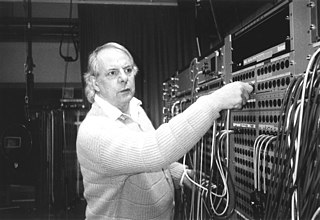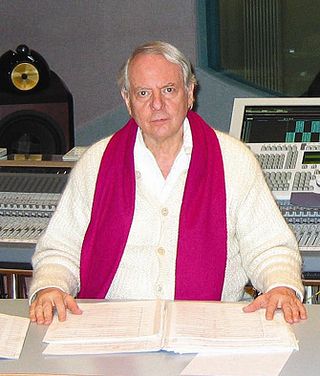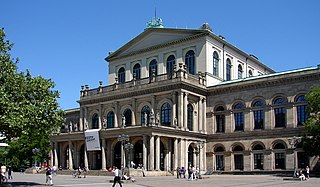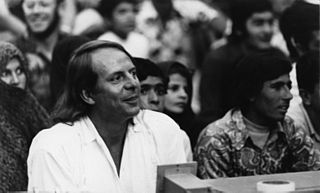
Karlheinz Stockhausen was a German composer, widely acknowledged by critics as one of the most important but also controversial composers of the 20th and early 21st centuries. He is known for his groundbreaking work in electronic music, having been called the "father of electronic music", for introducing controlled chance into serial composition, and for musical spatialization.

An overtone is any resonant frequency above the fundamental frequency of a sound. In other words, overtones are all pitches higher than the lowest pitch within an individual sound; the fundamental is the lowest pitch. While the fundamental is usually heard most prominently, overtones are actually present in any pitch except a true sine wave. The relative volume or amplitude of various overtone partials is one of the key identifying features of timbre, or the individual characteristic of a sound.

Overtone singing, also known as overtone chanting, harmonic singing, polyphonic overtone singing, or diphonic singing, is a set of singing techniques in which the vocalist manipulates the resonances of the vocal tract to arouse the perception of additional separate notes beyond the fundamental frequency that is being produced.

David Hykes is a composer, singer, musician, author, and meditation teacher. He was one of the earliest modern western pioneers of overtone singing, and since 1975 has developed a comprehensive approach to contemplative music which he calls Harmonic Chant. After early research and trips studying Mongolian, Tibetan, and Middle Eastern singing forms, Hykes began a long series of collaborations with traditions and teachers of wisdom and sacred art, including the Dalai Lama and the Gyuto and Gyume monks.

Gesang der Jünglinge is an electronic music work by Karlheinz Stockhausen. It was realized in 1955–56 at the Westdeutscher Rundfunk studio in Cologne and is Work Number 8 in the composer's catalog. The vocal parts were supplied by 12-year-old Josef Protschka. It is exactly 13 minutes, 14 seconds long.

Cymatics is a subset of modal vibrational phenomena. The term was coined by Swiss physician Hans Jenny (1904–1972). Typically the surface of a plate, diaphragm, or membrane is vibrated, and regions of maximum and minimum displacement are made visible in a thin coating of particles, paste, or liquid. Different patterns emerge in the excitatory medium depending on the geometry of the plate and the driving frequency.

Stimmung, for six vocalists and six microphones, is a piece by Karlheinz Stockhausen, written in 1968 and commissioned by the City of Cologne for the Collegium Vocale Köln. Its average length is seventy-four minutes, and it bears the work number 24 in the composer's catalog.

Mongol-Tuvan throat singing, the main technique of which is known as khoomei, is a style of singing practiced by people in Tuva and Mongolia. It is noted for including overtone singing. In 2009, it was included in the Representative List of the Intangible Cultural Heritage of Humanity of UNESCO. The term hömey / kömey means throat and larynx in different Turkic languages. That could be borrowed from Mongolian khooloi, which means throat as well, driven from Proto-Mongolian word *koɣul-aj.

Mikrophonie is the title given by Karlheinz Stockhausen to two of his compositions, written in 1964 and 1965, in which "normally inaudible vibrations ... are made audible by an active process of sound detection ; the microphone is used actively as a musical instrument, in contrast to its former passive function of reproducing sounds as faithfully as possible".

Freitag aus Licht, the main body of which is also titled Freitag-Versuchung, is the fifth to be composed of the seven operas that comprise Licht (Light), by Karlheinz Stockhausen. It was the last of the operas to receive a staged production with the composer's involvement.

Alphabet für Liège, for soloists and duos, is a composition by Karlheinz Stockhausen, and is Work Number 36 in the composer's catalog of works. A performance of it lasts four hours.

Jubiläum (Jubilee) is an orchestral composition by Karlheinz Stockhausen, work-number 45 in the composer's catalogue of works.
Michael Vetter was a German composer, novelist, poet, performer, calligrapher, artist, and teacher.

Spiral, for a soloist with a shortwave receiver, is a composition by Karlheinz Stockhausen, written in 1968. It is Number 27 in the catalogue of the composer's works.

Pole (Poles), for two performers with shortwave radio receivers and a sound projectionist, is a composition by Karlheinz Stockhausen, written in 1970. It is Number 30 in the catalogue of the composer's works.

Expo, for three performers with shortwave radio receivers and a sound projectionist, is a composition by Karlheinz Stockhausen, written in 1969–70. It is Number 31 in the catalogue of the composer's works.

Sternklang, is "park music for five groups" composed in 1971 by Karlheinz Stockhausen, and bears the work number 34 in his catalogue of compositions. The score is dedicated to his spouse, Mary Bauermeister, and a performance of the work lasts from two-and-a-half to three hours.

Für kommende Zeiten is a collection of seventeen text compositions by Karlheinz Stockhausen, composed between August 1968 and July 1970. It is a successor to the similar collection titled Aus den sieben Tagen, written in 1968. These compositions are characterized as "Intuitive music"—music produced primarily from the intuition rather than the intellect of the performer(s). It is work number 33 in Stockhausen's catalog of works, and the collection is dedicated to the composer's son Markus.

For the Welsh retired track and road racing cyclist, see Megan Hughes.

Entangled Life: How fungi make our worlds, change our minds and shape our futures is a 2020 non-fiction book on mycology by British biologist Merlin Sheldrake. His first book, it was published by Random House on 12 May 2020.
















